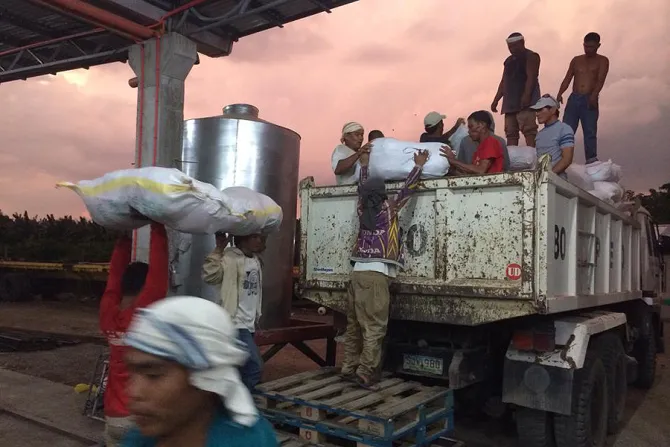Manila, Philippines, Dec 22, 2014 / 15:07 pm
The Church in the Philippines has stepped up round the clock rehabilitation and relief measures for the population affected by the country's most recent typhoon, Hagupit, which struck earlier this month.
Hagupit, locally known as "Ruby", ripped through the archipelago's central belt Dec. 7 with heavy rains and wind that left 21 dead and over 900 injured, besides leaving thousands of people displaced on the islands of Samar and Leyte.
"The faith of our people is undeterred despite these mounting dark clouds and surrounding typhoons," Gilda Avedillo, program officer for Caritas Manila's disaster risk reduction and management program, told CNA Dec. 18.
The Philippines continues to recover from the vast destruction and loss of life caused by 2013's Typhoon Haiyan, which killed more than 7,300 and displaced millions from their homes.
A week before Typhoon Hagupit made its strike, Radyo Veritas, the local Catholic radio network, was assigned as the communication arm of Caritas Manila during disaster operations in providing regular updates and assessment reports to Caritas Manila.
Avedillo recounted that Caritas Manila activated immediately round the clock Incident Command System, continuously assessing and monitoring with its volunteers and partners along with other agencies and diocesan social action centers, to mitigate disastrous effects, and dispatching relief kits to the distressed areas.
Several dioceses reported massive flooding, in the provinces of Eastern Samar, Northern Samar, and Leyte, leading to damage to shelters and crops. Large number of people were evacuated and housed in schools and institutions in safer zones.
Archbishop of Socrates Villegas of Lingayen – Dagupan in his appeal on Dec. 5 urged all schools and churches to "open their doors to refugees" ahead of the typhoon.
Avedillo recounted that initially with the impact of the massive flooding, destruction of roads and communication systems impeded in transmitting essential supplies such as food, water, medicine, and hygiene kits for those in the evacuation centers in parts of Samar.
According to National Disaster Risk Reduction and Management Council some 4.1 million were affected by the storm; 1 million are currently in evacuation centers; and more than 290,000 homes were damaged or destroyed.
Avedillo explained that Caritas Manila is delivering thousands of food relief packs and scores of first aid and hygiene kits to the distressed areas in 13 dioceses.
Caritas Manila has made available resources from its Lenten Campaign (Alay Kapwa) and other stakeholders, who are ready to support the needs of the affected communities of Typhoon Ruby together with its partners.
"Still, much more to be achieved", Avedillo stressed. "Currently the needs are non-food items for wash interventions and structural materials for repairing damaged houses."
Avedillo praised Catholic Relief Services, which has played a "very important role" for information exchange and has been an extensive partner of Caritas Manila in several trainings, projects and field monitoring and in relief rehabilitation assistance program.
With the typhoons the agro-economy has suffered a terrible loss to coconut and banana plantations, farming and livestock. Rice crops have been swept away, which is a major staple food of the Filipinos, and it has affected the livelihood of farmers.
"We keep our faith and prayers and we move ahead to prepare the birth of our Saviour Jesus," Roseryn Kyle, a local youth, told CNA Dec. 19.
"We are eagerly waiting and praying for the safety of our Holy Father visiting us early next month."
The Quiapo Church Disaster Preparedness and Response Ministry (DRRM), a scientific office of the local Church is closely monitoring prospective natural disasters in the island nation in collaboration with governments other geophysical science organizations.
DRRM also provides up-to-date text messages to registered users, so that they can make preparations and take safety measures when a disaster is expected, helping to prevent casualty and loss of life.


